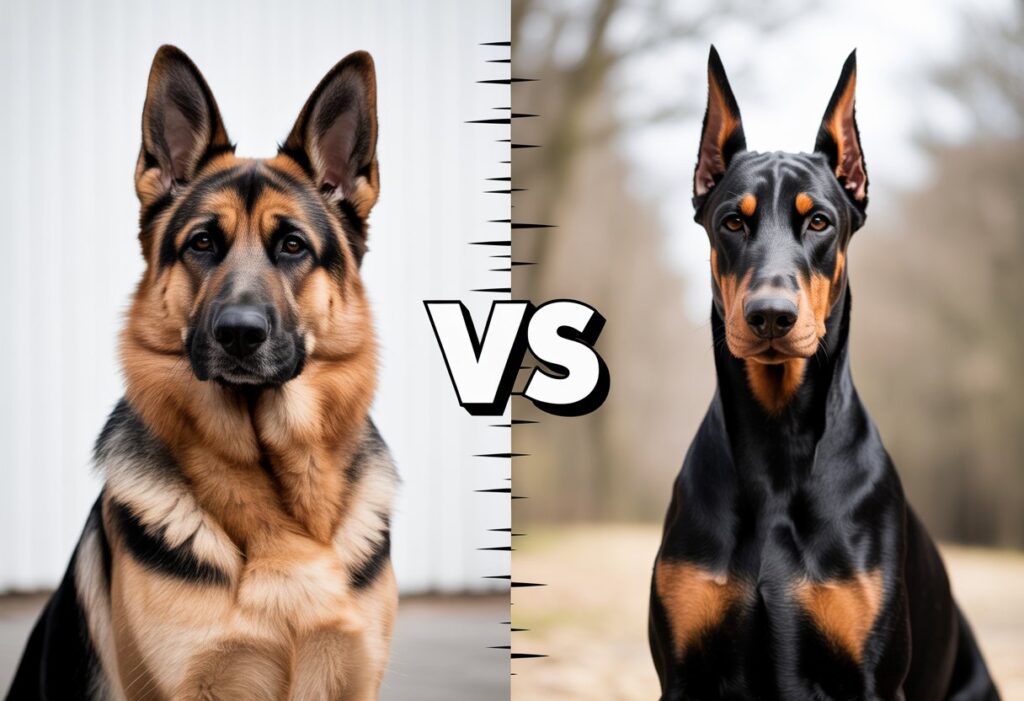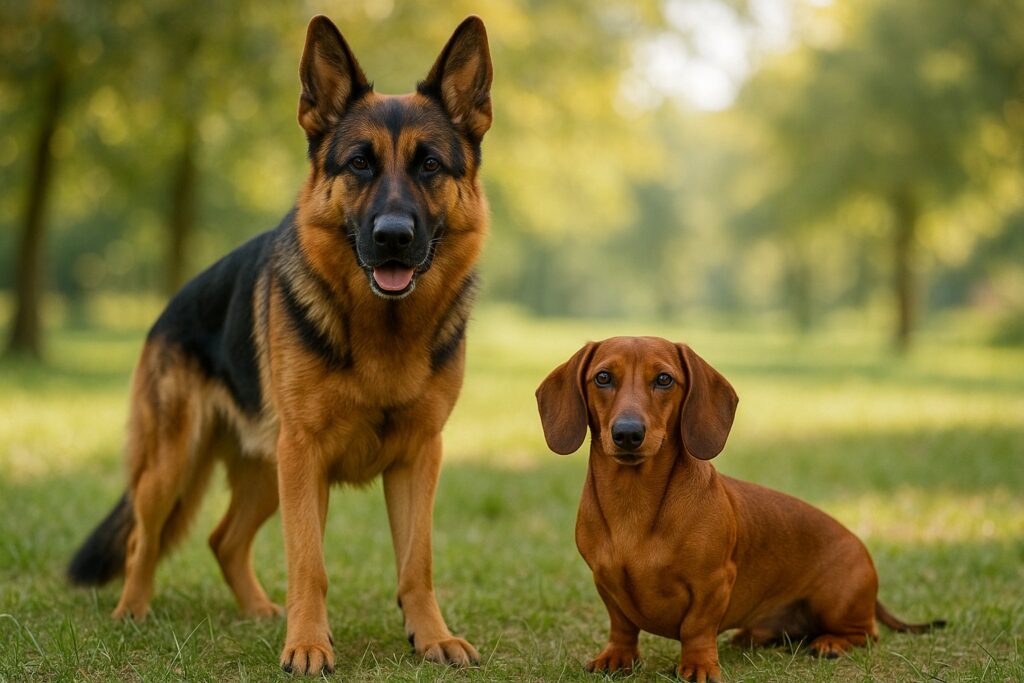If you’re torn between a German Shepherd and a Doberman Pinscher, you probably want the real scoop. Both breeds are loyal, smart, and strong, but their quirks might make one a better fit for your life.
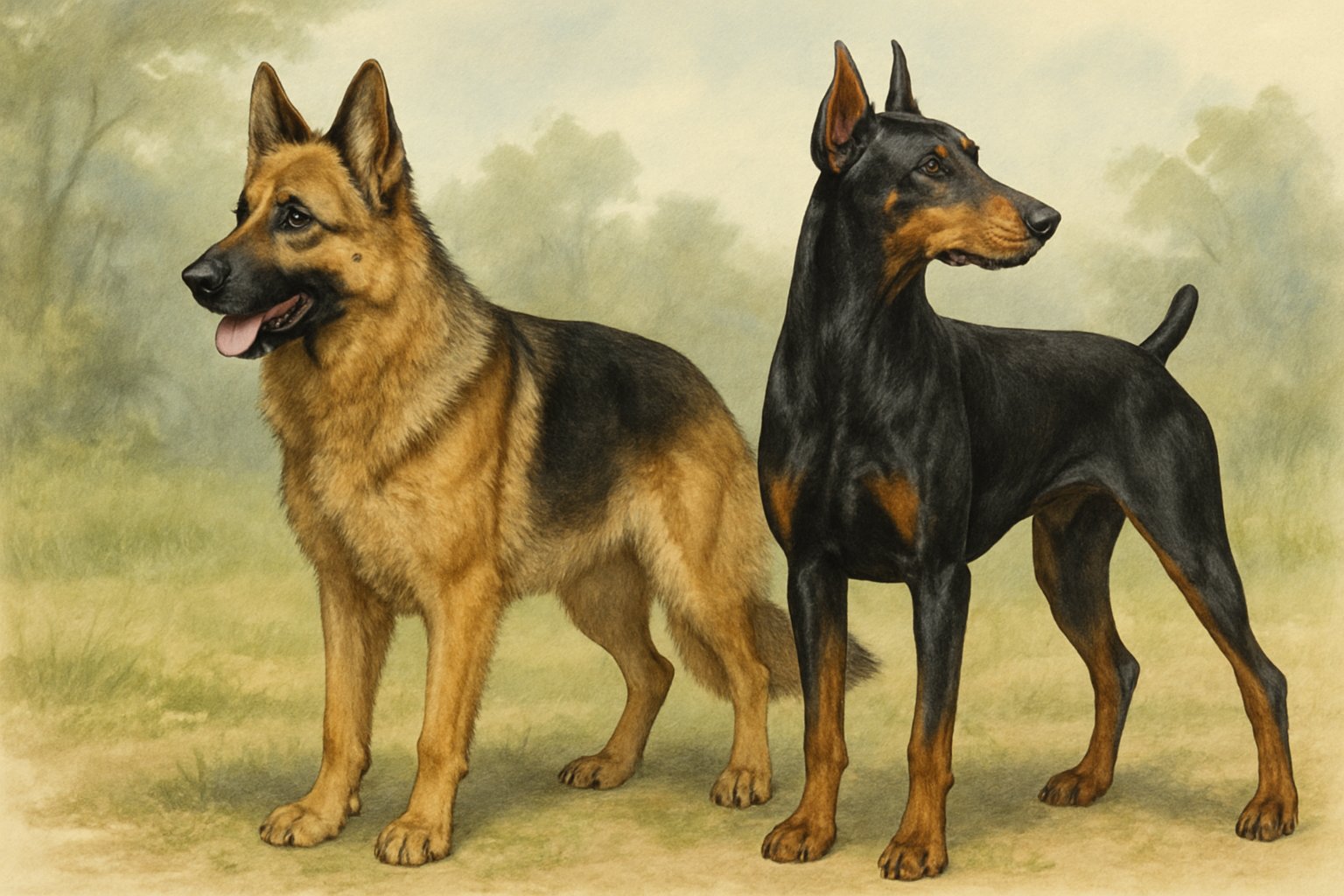
You might be thinking about which dog’s easier to train or which one’s the best family fit. Maybe you just want the best protector on the block. These are big questions, and it’s worth digging into what sets these breeds apart.
Key Takeaways
- Each breed brings its own history and personality.
- They look different and need different care.
- Both can be loyal family members and solid guardians.
Breed Origins and History
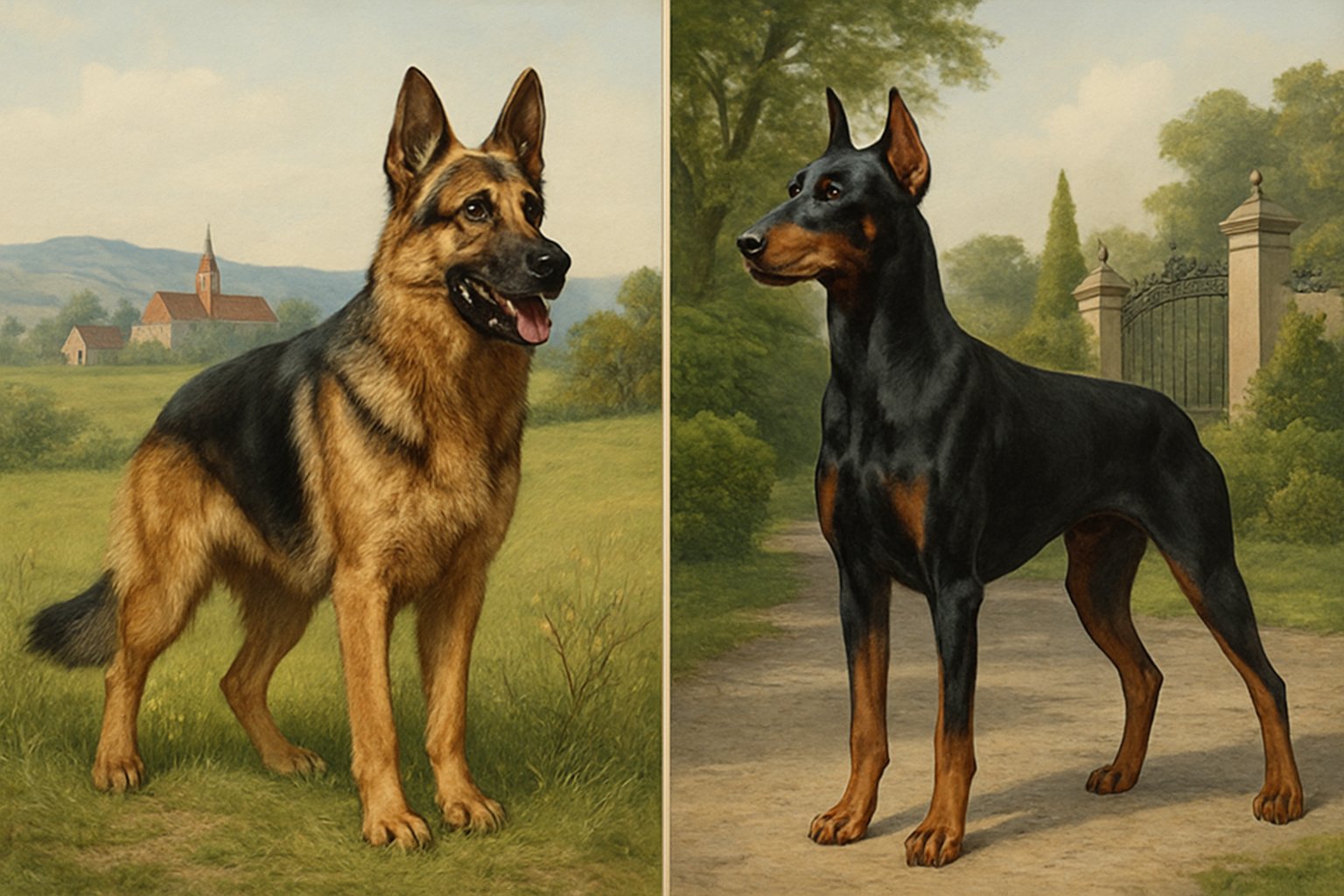
The German Shepherd and Doberman Pinscher have roots in Germany, but their backstories are pretty different. These backgrounds shaped them into some of the world’s favorite working dogs.
German Shepherd Historical Background
The German Shepherd popped up in Germany in the late 1800s. Captain Max von Stephanitz wanted a sharp, trainable herding dog, so he mixed several breeds to get there.
He aimed for a dog that was obedient and quick to learn. German Shepherds didn’t just stay on farms—they got noticed in World War I as messenger and rescue dogs.
The American Kennel Club recognized them in 1908. Since then, German Shepherds have worked with police and military worldwide.
Their reputation for courage and versatility is hard to beat.
Doberman Pinscher Origins and Louis Dobermann
Dobermans also came from Germany, a little later in the 1800s. Louis Dobermann, a tax collector, needed a bodyguard, so he started mixing breeds like the Rottweiler, Greyhound, and German Pinscher.
He wanted a dog that was alert, loyal, and brave. The Doberman’s slim build and sharp senses made people take notice.
The American Kennel Club added Dobermans in 1908. These dogs quickly gained fame as protectors and working dogs.
Development as Police and Guard Dogs
Both breeds started as working dogs and ended up as favorites for police, military, and security work. They’re loyal, smart, and brave—traits that make them naturals for tough jobs.
A side-by-side look:
| Breed | Police Work | Guarding | Service Roles |
|---|---|---|---|
| German Shepherd | Widely used | Trusted | Search, rescue |
| Doberman Pinscher | Less common | Highly used | Security, protection |
You’ll see German Shepherds in search and rescue or detection. Dobermans show up more as personal guard dogs.
Physical Characteristics and Size
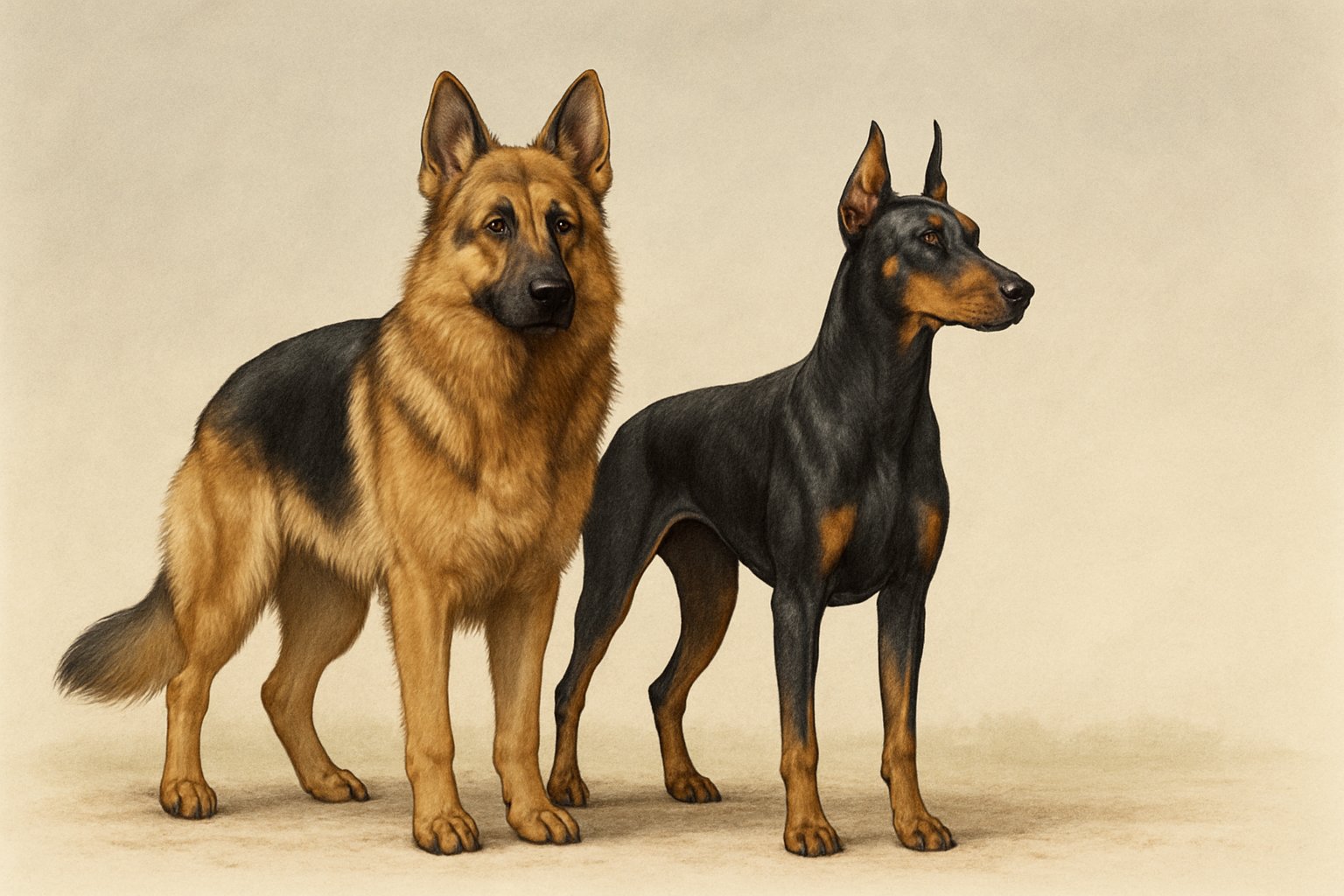
German Shepherds and Dobermans look pretty different, from their coats to their overall build. They also have different grooming needs and shed at different rates.
General Appearance Comparison
German Shepherds are strong and muscular, with a slightly long body and a thick double coat. Their ears stand up, and their bushy tails hang down.
Dobermans are more streamlined. They have a short, smooth coat and a compact, square build. Their ears are often cropped, and tails docked, though that depends on where you live.
German Shepherds usually come in black and tan or black and red. Dobermans are often black, red, blue, or fawn with rust markings.
Size and Weight Differences
Here’s a quick comparison:
| Breed | Height (inches) | Weight (pounds) |
|---|---|---|
| German Shepherd | 22–26 | 50–90 |
| Doberman Pinscher | 24–28 | 60–100 |
Dobermans are generally a bit taller and heavier, but there’s some overlap.
Male German Shepherds usually stand 24 to 26 inches at the shoulder, with females a bit shorter. Dobermans range from 24 to 28 inches tall.
Both breeds look powerful, but Dobermans are slimmer.
Shedding and Grooming Needs
German Shepherds shed—a lot. Their double coat means hair everywhere, especially in spring and fall. You’ll need to brush them several times a week, maybe even daily during heavy shedding.
Dobermans have it easier in the grooming department. Their short, smooth coat just needs a quick brush once a week.
Neither breed needs haircuts, but you should keep their nails trimmed and ears clean.
Temperament, Behavior, and Intelligence
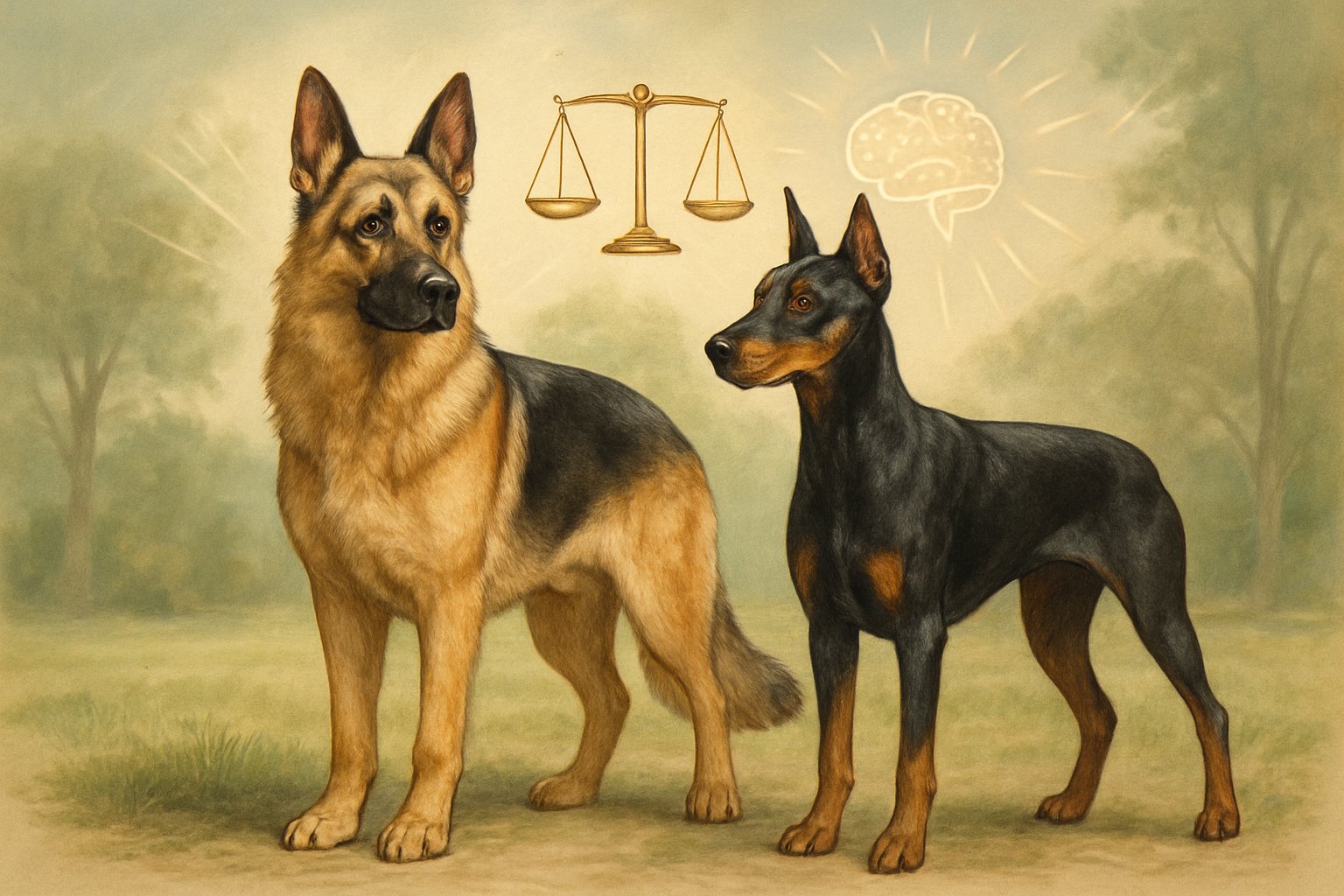
German Shepherds and Dobermans are both smart and loyal, but their personalities aren’t identical. Each breed brings a different vibe to the table.
Personality Traits and Socialization
German Shepherds are steady and alert, but not usually jumpy. With early socialization, they’re confident around people and make good family dogs.
Dobermans have a bolder edge. They’re protective and sometimes more energetic. If they don’t get enough socialization, they can get wary of strangers.
German Shepherds tend to be patient with kids and other animals if raised with them. Dobermans can be loving too, but sometimes need more training to avoid rough play.
Intelligence and Trainability
Both breeds are among the smartest dogs. German Shepherds love to learn and catch on fast.
Dobermans are quick studies, too, but they’ll get bored if training is too easy or always the same. Mixing up routines and using positive rewards keeps them engaged.
Start obedience training early for both breeds. Puzzle toys and advanced commands help keep their minds busy.
Aggression, Loyalty, and Guard Dog Instincts
Both breeds are loyal and make natural protectors. German Shepherds usually stay calm but will defend their home if needed.
Dobermans have stronger guard instincts and can look pretty intimidating. With poor socialization, they might get too suspicious of strangers.
Training helps both breeds manage their guarding behavior. When you teach them to tell friend from foe, they’re truly reliable protectors.
Family Compatibility and Companion Roles
German Shepherds and Dobermans both show up on lists of family dogs. How they fit in with kids and other pets depends a lot on their upbringing and daily life.
Family Pets and Children
German Shepherds are usually protective and gentle with kids if they grow up together. Their intelligence makes them good therapy or guide dogs, too.
Dobermans bond closely with family and can be affectionate. They might be cautious around strangers, but with socialization, they’re patient with children.
Compared to breeds like Golden Retrievers or Labradors, German Shepherds and Dobermans need clear rules and steady leadership. Smaller breeds, like Pugs or Chihuahuas, might be easier indoors but aren’t as protective.
Socialization With Other Dogs and Animals
Early socialization is a must. German Shepherds can get along with other dogs, but sometimes want to herd or guard.
Slow introductions to pets like cats or smaller dogs—Boxers, Bulldogs, or Mastiffs—help cut down on chasing or dominant behavior.
Dobermans can be friendly with other animals but might show dominance, especially with dogs of the same sex. Supervised play and group classes teach good manners.
Regular walks and new environments help both breeds adjust to life with other pets.
Health, Lifespan, and Exercise Needs
German Shepherds and Dobermans are big, active dogs with specific health and exercise needs. Paying attention to these can make a huge difference in their lives.
Common Health Issues and Hip Dysplasia
Both breeds are prone to certain health conditions. Hip dysplasia is especially common in German Shepherds, causing pain and arthritis as they age.
Dobermans are more likely to develop dilated cardiomyopathy (DCM), a heart issue. Both breeds can face bloat, skin allergies, and degenerative myelopathy.
Early health screening and regular vet visits are key. If you’re buying from a breeder, ask about health clearances for hips and hearts.
Life Expectancy Comparison
German Shepherds usually live around 9 to 13 years. Hip problems, spinal diseases, and cancer can affect their lifespan.
Dobermans typically make it to 10 to 12 years. DCM is a big risk and can be sudden. Dobermans also face Wobbler syndrome as they get older.
Genetics, care, and good health screening all matter. Feeding them well and keeping their weight down helps, too.
Physical and Mental Stimulation Requirements
Both breeds need at least 1 to 2 hours of exercise every day. Long walks, running, and playtime in a fenced yard are great.
Mental exercise is just as important. German Shepherds love training and jobs that use their brains. Dobermans enjoy problem-solving and learning new tricks.
If they don’t get enough to do, both breeds can get bored and act out. Regular play, training, and puzzle toys help keep them happy and healthy.
Guarding Ability and Working Roles
Both the German Shepherd and Doberman Pinscher have built reputations for strength and intelligence. People trust them for tough jobs that demand reliability.
Their roles as guard dogs, police dogs, and service animals really show off their unique skills. You can spot differences and similarities when you look at how they work.
Guard Dog Performance and Bite Force
German Shepherds often serve as guard dogs because they’re loyal and super alert. They pick up on threats fast and usually follow commands without much fuss.
Their protective instincts make them a favorite for families and businesses looking for security. It’s not surprising—they just seem to know when something’s off.
Dobermans do a great job as guard dogs, too. They’ve got strong territorial instincts and react quickly if someone trespasses.
People often say Dobermans are fearless, maybe even a bit more intense than German Shepherds when it comes to protection. There’s a certain edge to their presence.
Bite force matters when you’re talking about jaw strength. German Shepherds bite at about 238 PSI (pounds per square inch).
Dobermans come in just a bit higher, with a bite force around 245 PSI. Both breeds can deliver a powerful bite, which definitely helps when they need to stop a threat.
| Breed | Typical Bite Force (PSI) | Common Use as Guard Dog |
|---|---|---|
| German Shepherd | 238 | Yes |
| Doberman | 245 | Yes |
Service, Police, and Therapy Work
German Shepherds show up in all sorts of important jobs. You’ll spot them helping police track suspects or search for missing people.
They also sniff out drugs with impressive accuracy. As service dogs, they’re among the top choices for people with disabilities.
Their calm, focused personalities make them surprisingly good therapy dogs too. It’s honestly hard not to admire their versatility.
Dobermans don’t appear as often in service or therapy roles, but they’re still trusted in police work. They’re lightning-fast and always alert, which makes them excellent at guarding and chasing down suspects.
Most folks don’t pick Dobermans for therapy work, but when it comes to protection or obedience-heavy jobs, they shine. Some families or handlers just want that dedicated protector vibe, and Dobermans really fit the bill.

